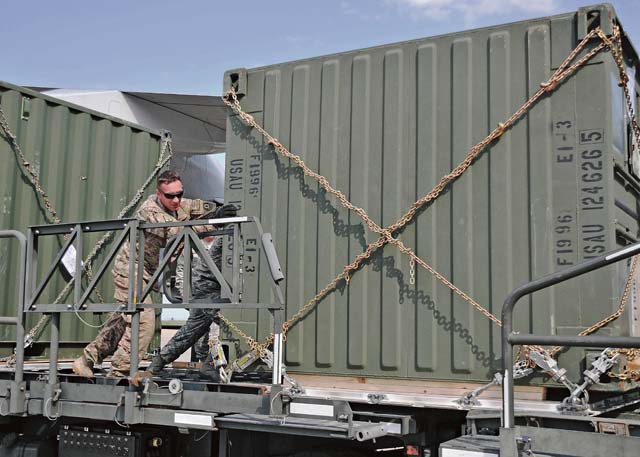
MIHAIL KOGALNICEANU, Romania — Using a process called multi-modal transportation, the 21st Theater Sustainment Command oversaw and coordinated the movement of equipment in more than 200 TRICON type containers from their home station in Vilseck, Germany, to their unit, the 2nd Cavalry Regiment, in Afghanistan, beginning June 21 and spanning the course of 28 days.
Multi-modal transportation is a process that “uses different modes of transportation to move cargo and personnel from one point to another,” said Chief Warrant Officer 3 Sean Lockwood, the multi-modal officer in charge for the 21st TSC and a native of Bronx, N.Y.
Forward positioned as a hub in Europe, the 21st uses multi-modal logistics to transit equipment rapidly and efficiently between the U.S., Europe, Africa and Central Command AORs. In the past, units moving equipment in and out of the U.S. Central Command area of operations moved equipment solely by boat or plane, which often inflates cost and increases time of transit. By analyzing routes and costs, the 21st TSC uses its central location to move equipment over a combination of land, sea or air to its final destination.
The 21st TSC made the multi-modal process possible by moving and tracking all equipment from Germany into Romania by way of train. Soldiers from the 21st TSC also ensured the equipment cleared customs, that contracts were in order and all documentation for movement was available so all personnel and equipment could fly into Afghanistan.
“Most of it is general cargo and supplies that the Soldiers will need while downrange,” said Sgt. Sheryl Willson, the 2 CR’s regimental transportation noncommissioned officer in charge and a native of Maui, Hawaii. “Within three weeks, we’ve already pushed out more than 90 percent of the containers, and the Soldiers in the fight are getting the equipment they need.”
The successful movement of the more than one million pounds of equipment was a result of the teamwork and synchronization of the 21st TSC, 2 CR, the 16th Sustainment Brigade, and the Air Force’s 435th Contingency Response Group.
“There are quite a few units that have to come together every day and interact with each other to make this work,” said 1st Lt. Andrew Miller, a movement control officer with the 627th Movement Control Team, 16th Sustainment Brigade, and a native of Brooklyn Park, Minn. “With this mission, it’s the coordination you have to do with the deploying unit, the host nation, and the local personnel that work at the base; it’s a whole host of personnel that have to come together to make this happen.”
The 21st TSC was ultimately responsible for making sure the mission was a success, said Lockwood. “We do all of the synchronization between the Air Force, the deploying unit, the MCT and the pallet builders to make sure everyone comes together and understands what the mission is.”
“You need to have the 21st TSC on the ground, because we have the logistical knowledge to get the job done,” said Lockwood. “We have the manpower and the knowhow to recommend to commanders how to get their cargo, equipment and personnel into an area safely and effectively to do their job.”
Originating in Vilseck, Germany, the containers were transported to Mihail Kogalniceanu, Romania, on rail cars where they were transported on cargo planes into Kandahar, Afghanistan, over the course of nine trips. The whole process took just over three weeks, allowing the 2 CR Soldiers to become fully mission capable in Afghanistan in a much shorter time than in the past.
“What they were doing at first was everything would leave via Bremerhaven Port, Germany, and it would have to go the long way around the Caspian Sea with a transition time of about 40 days,” said Lockwood. “What we did here is we railed everything, which takes about four days from Germany into [Romania], then we airlifted it straight into Kandahar.”
According to Sgt. 1st Class Tamecha Chalmers, the senior movement NCO for the 21st TSC and a native of Hope Mills, N.C., the multi-modal transportation method through Romania not only saves time, but is also a much more cost effective way of ensuring the Soldiers in Afghanistan receive their equipment. “Moving the containers via rail into Romania has saved the 21st TSC a lot of money,” added Chalmers. “Anytime you’re going by land, whether it be rail or truck, it’s much more cost effective.”
“It is cheaper to send things via air from [Romania] than having to vessel them from Germany to Afghanistan,” said Willson. “It is more cost effective and, if you weigh the money and time, this is the best place to get the cargo from its point of origin to the Soldiers.”


